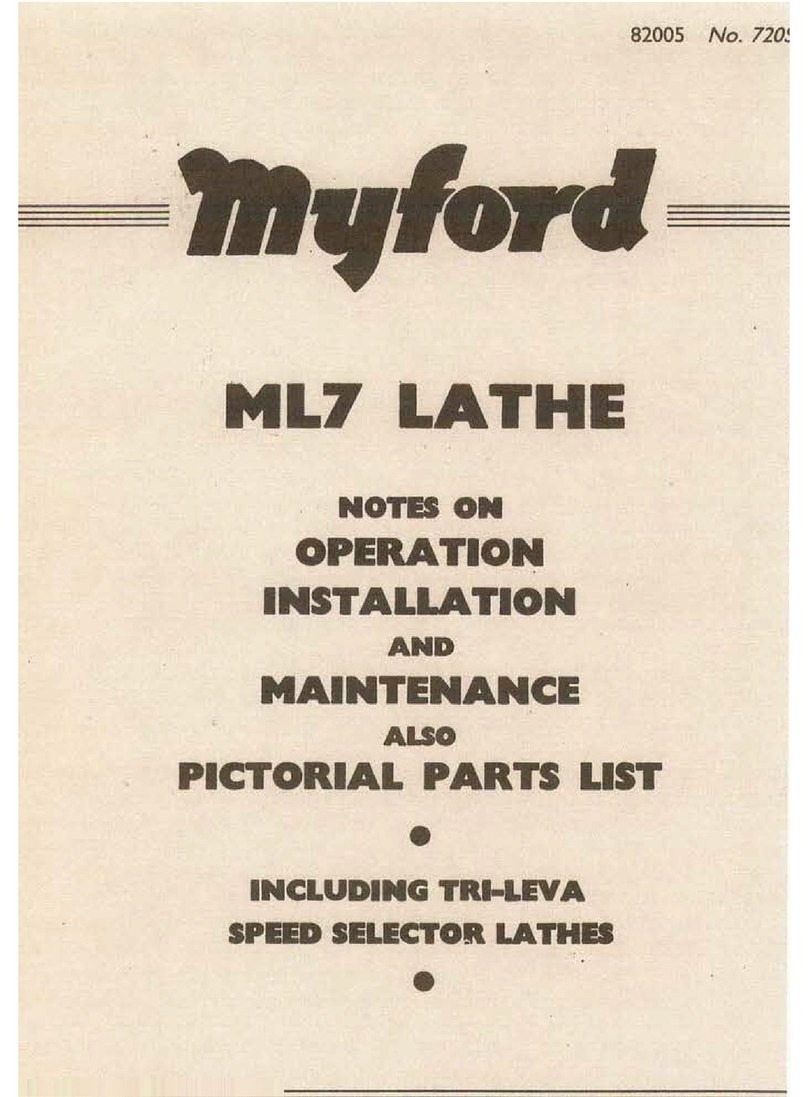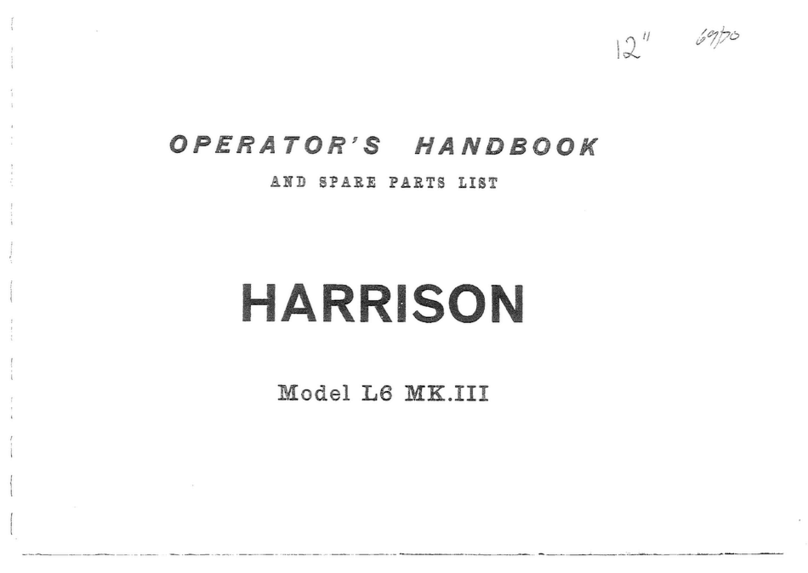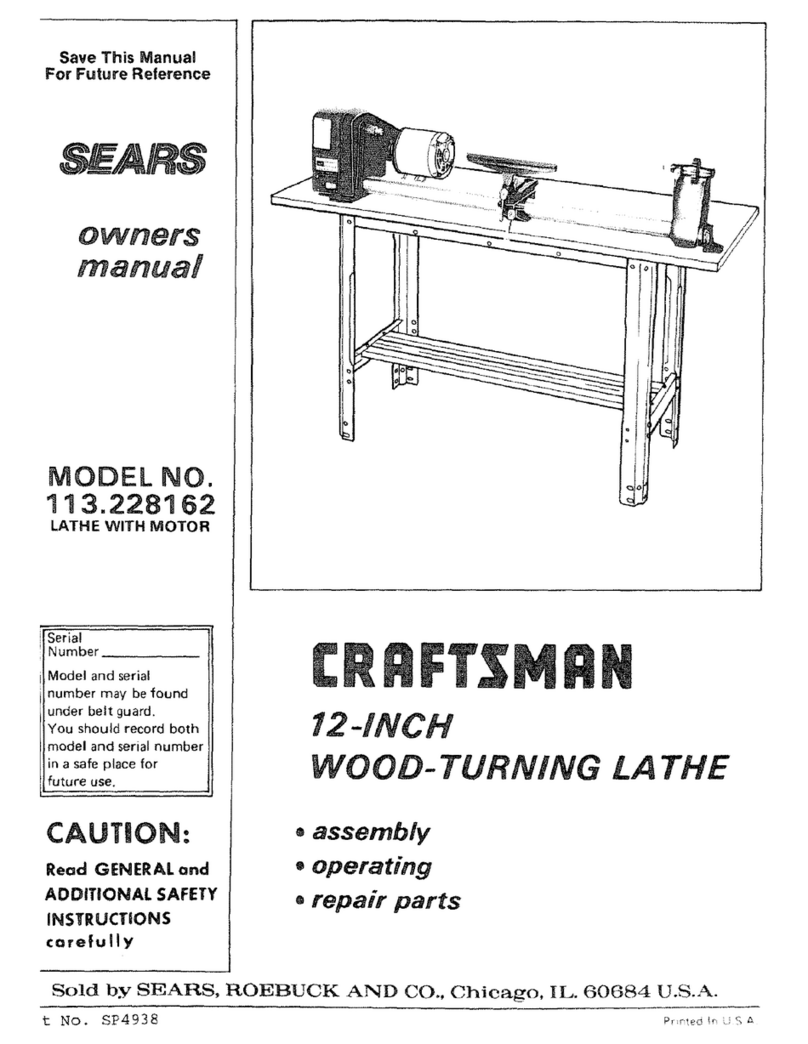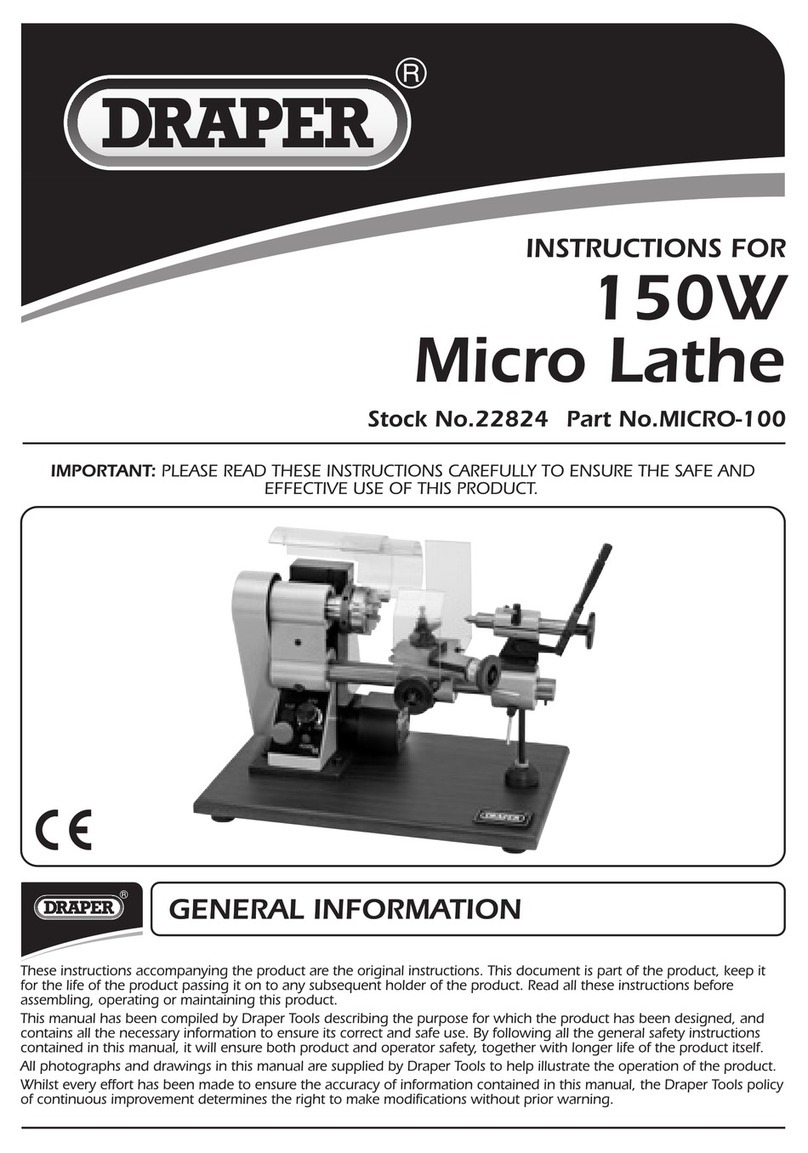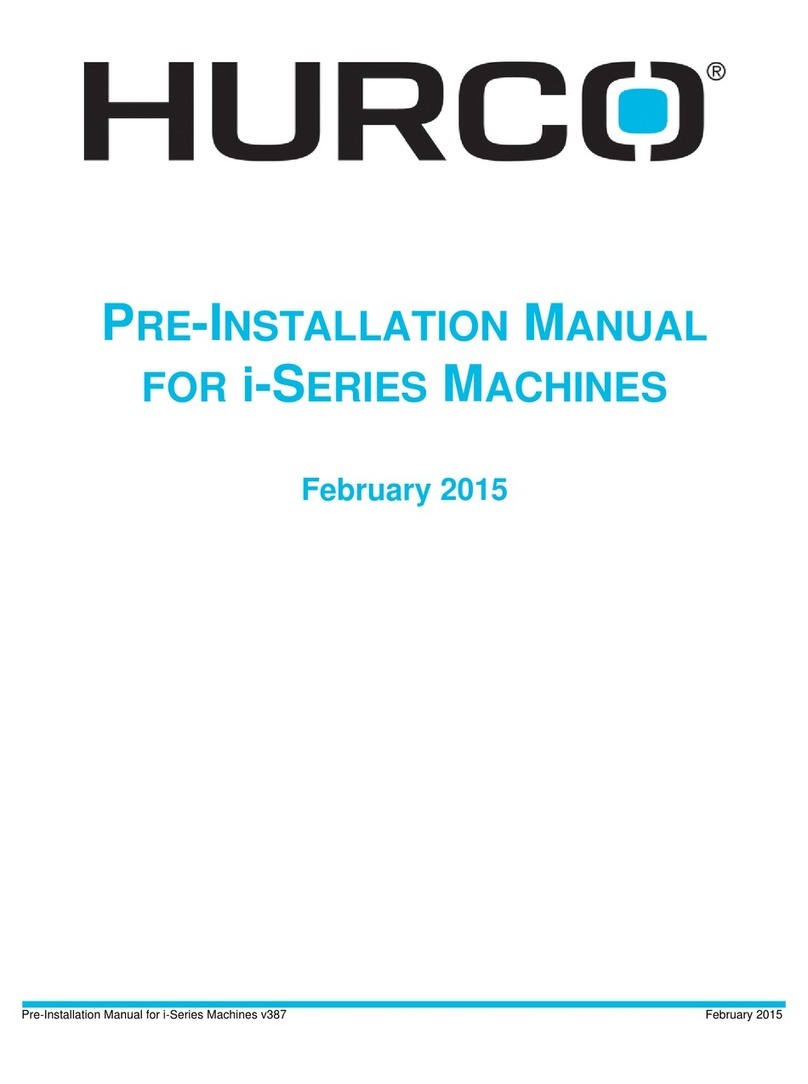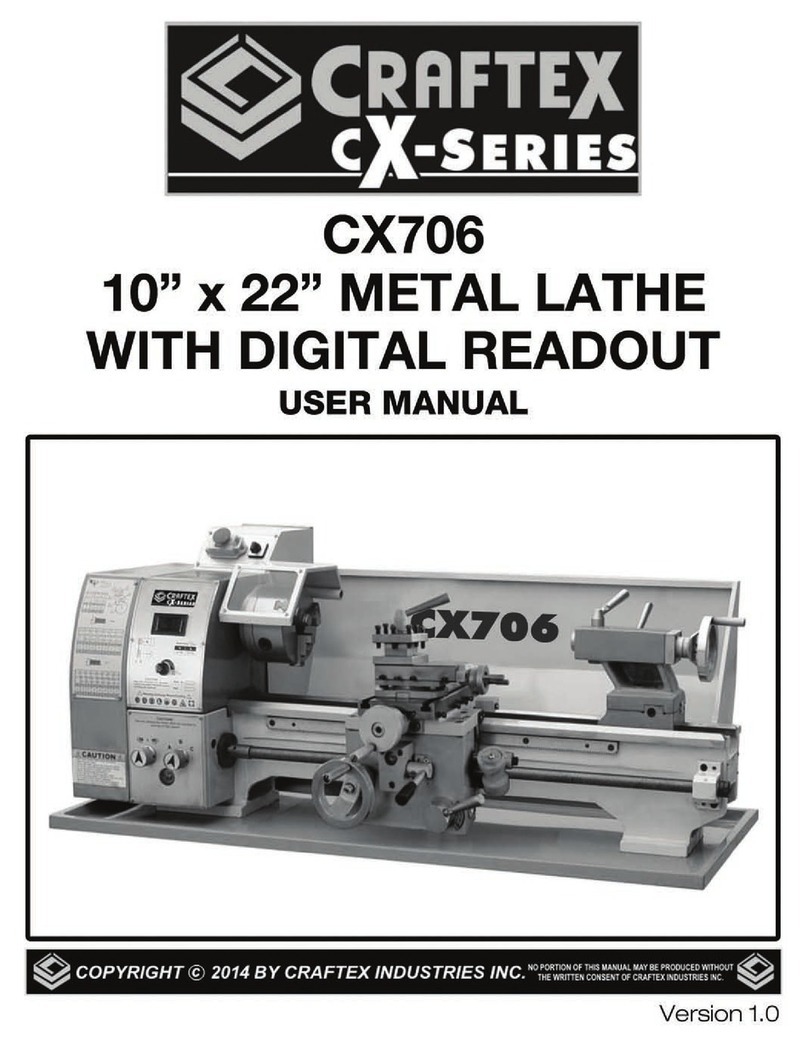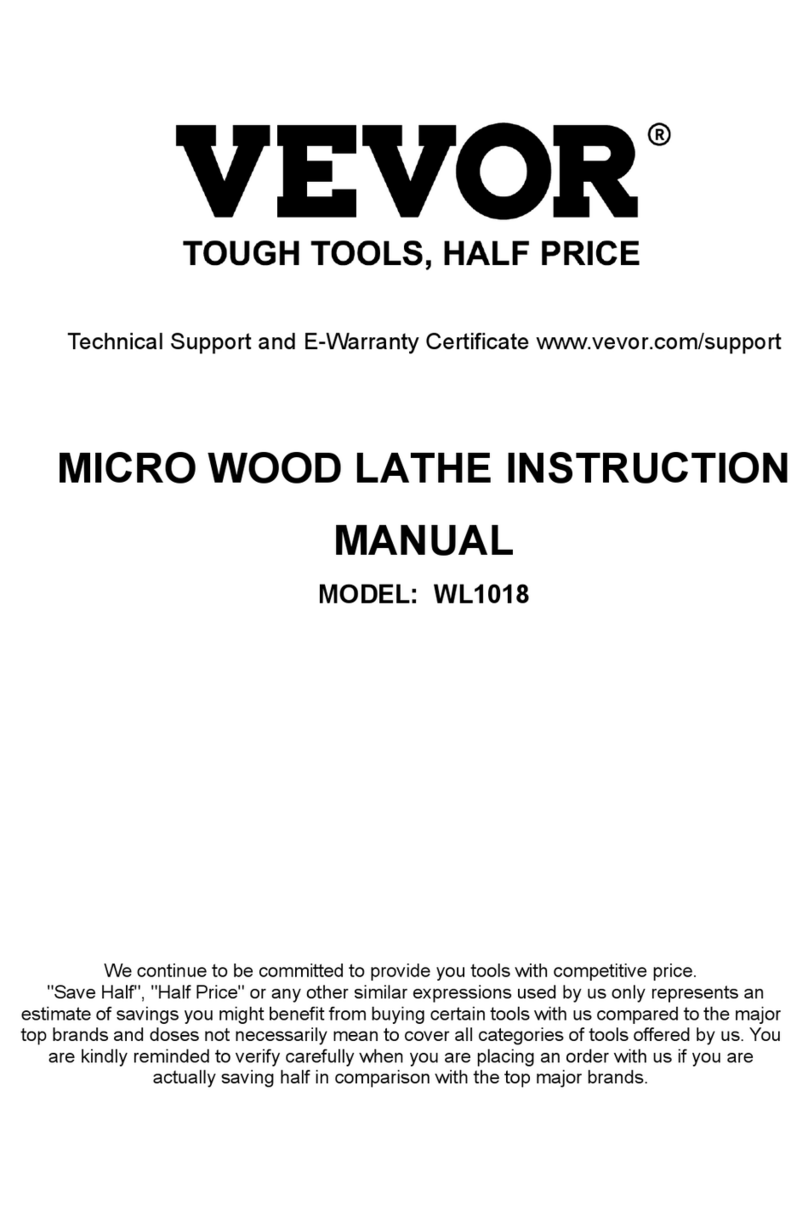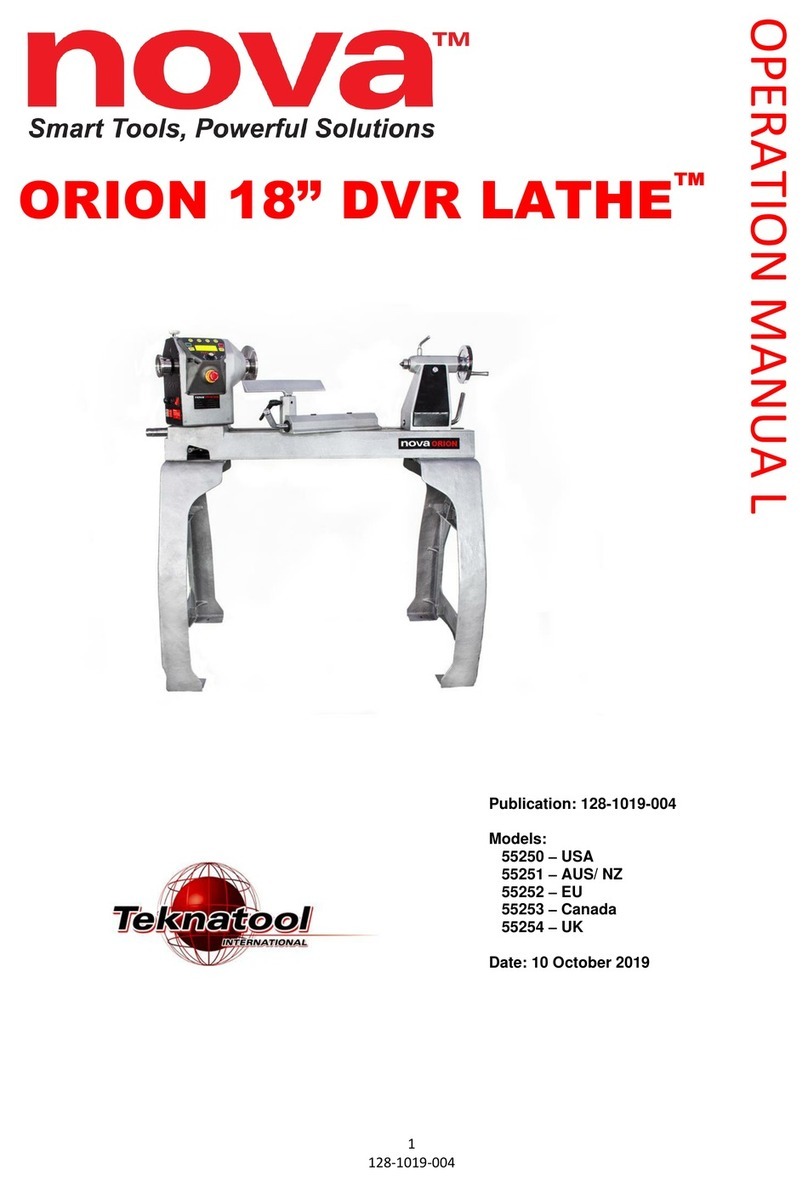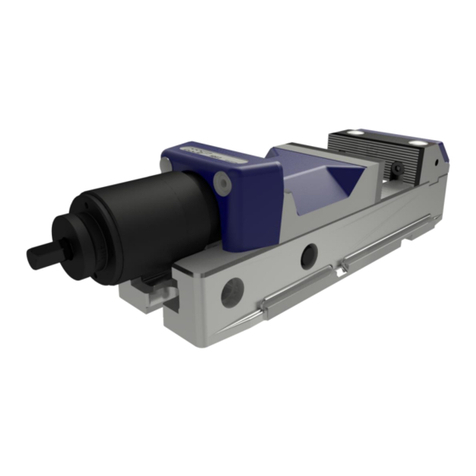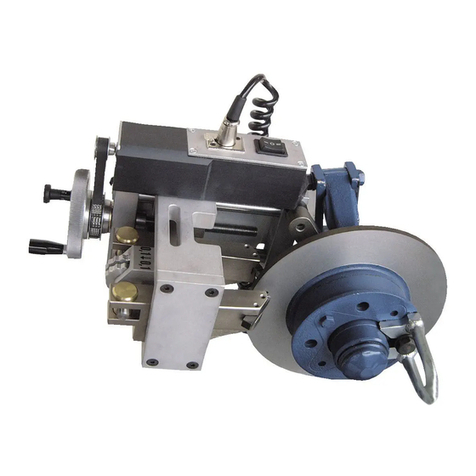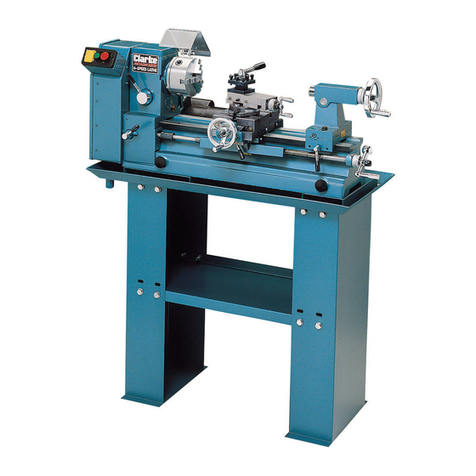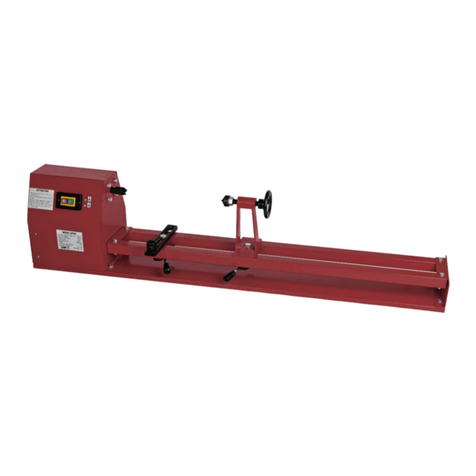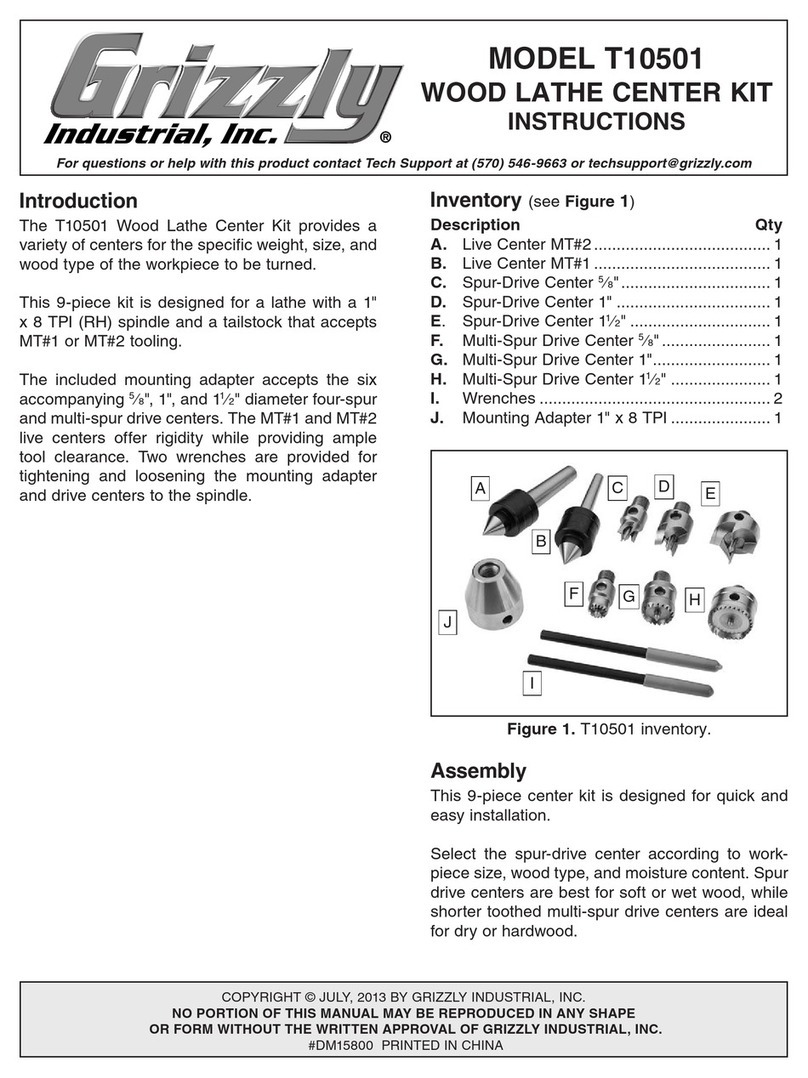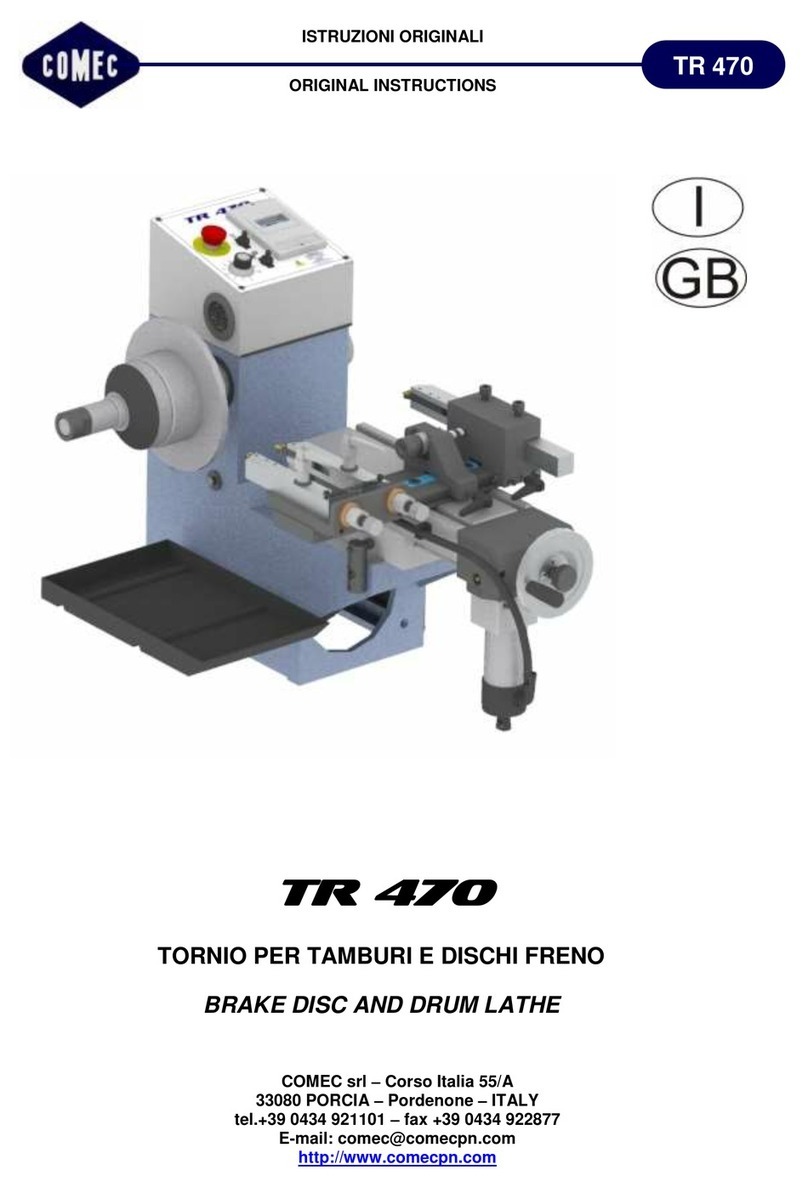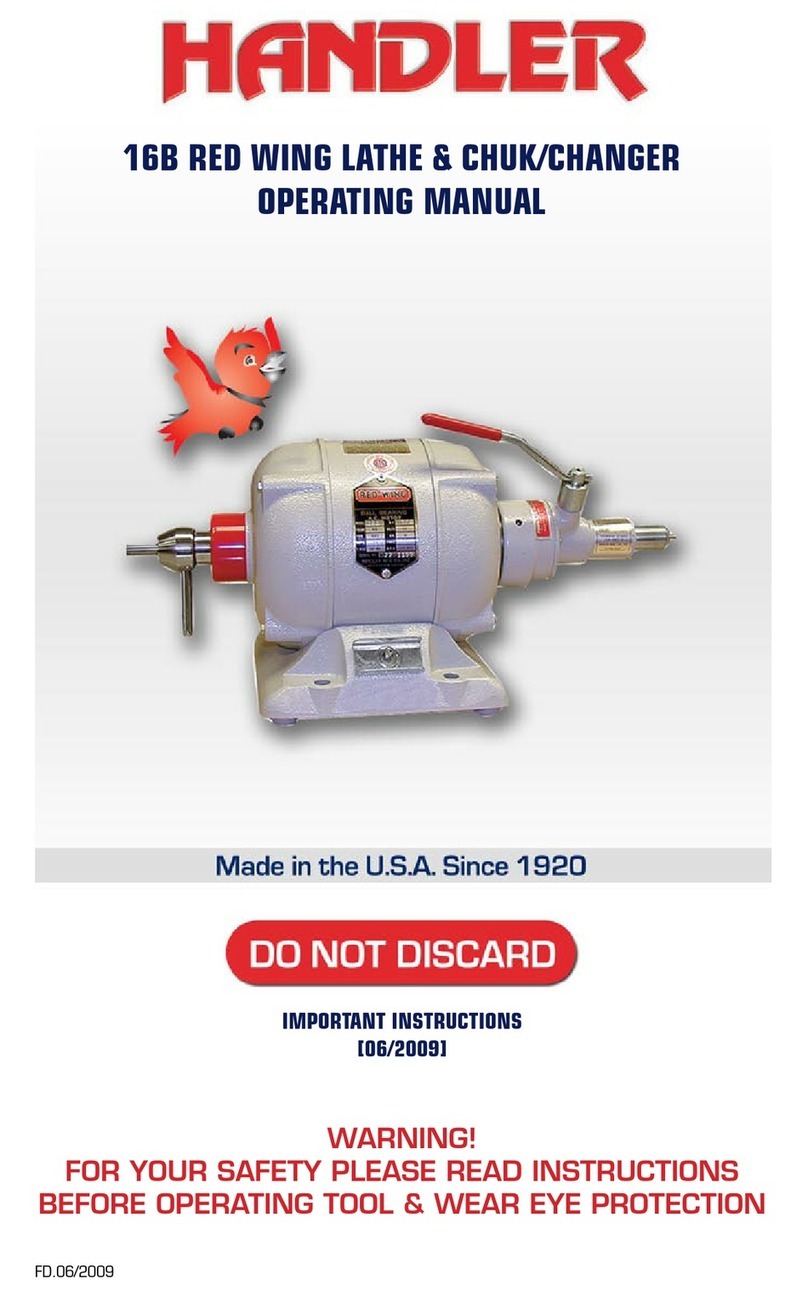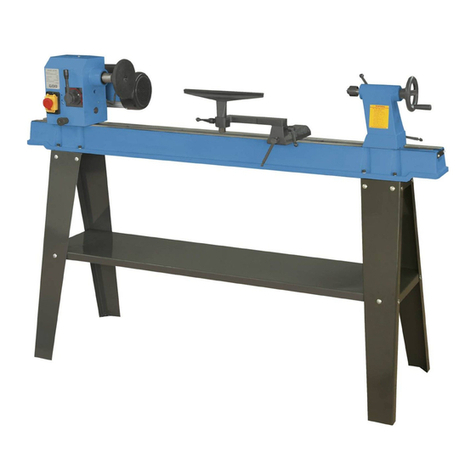Myford ML 8 User manual

Installation
Lubrication
Adjustments
Parts List


Dr'g
1+
2+
3+
4
5
6+
7+
8
9+
10
11
12+
13
14
15
16
17
18
19
20
21
22
23
24
25
26
27
28*
29
30
31
32
33
34
35
36
37
38
39
40
41
42
43
44
45
46
47
48
49
50
54
Part Number
C1000/1
73016
C1001
Description
Headstock,
Metric Part No. C1000A
Ball bearing (front) (R & M MJT 1 1/8."), Metric Part No. 73039 (RHP 7306)
Bearing cover (front),
Hexagon head screw (1/4" B.S.F. x 3/4")
Washer (1/4")
Ball bearing (rear) (R & M MJT 1"),
Bearing cover (rear),
Oil plug
Spindle
Pulley
Metric Part No. C1001A
73015
C1002
C1116
C1006/1
C10.08
C1010
11253
73017
C1043/1
C1084/1
73018
11311
C1041
A3017
75/1909
11254
C4040
C6621
C1029
C1104
C8805
C1024
11278
C1025/1
C1018
C1020
C1021
C7964
C1026
C1075/1
C1076/1
C1028
C1012
65010
C1019
C1046
C1836
C1015
75/1506
01037
Metric Part No. 73040 (RHP 7305)
Metric Part No. C1002A
Metric Part No. C1006A
Socket set screw (1/4." B.S.F. x 1/2", cup point, 'Wedglok')
Adjusting collar
Copper pad
Metric Part No. C1010A
Socket set screw (1/4" B.S.F. x ¼"', cup point)
Oilite bush (CT55 x 3/8")
Index plunger
Knob
Steel ball (7/32" dia.)
Compression spring
Socket set screw (1/4" B.S.F. x 1/4", cup point)
Headstock cover
Stud
Knob
Copper pad
Socket set screw (3/8" B.S.W. x 5/8", cup point)
Serial number plate
Rivet (NPK type U No. 0 x 3/16")
Bed (36" between centres) or
End support
Spherical washer
C6622 Bed (42" between centres)
Hexagon head screw (3/8 " B.S.W. x 1 1/4.")
Saddle
Grub screw (1/4" B.S.F. x 3/16")
Clamp bolt
Tube support
Washer
Quick nut
Lever assembly
Handrest support
Bolt head
Handrest (10")
Clamp screw assembly
Tailstock body
Ball type oiler (Adams style A No. 1402)
Clamp bolt
Tailstock barrel
Hand wheel assembly
Thrust plate.
Round head screw (4 B.A. x 3/4")
Barrel locating key
Swing bracket
Q'ty
1
1
1
4
8
1
1
2
1
1
4
1
2
2
1
1
1
1
1
1
1
1
1
2
2
1
2
1
1
1
1
1
4
1
2
4
3
4
1
1
1
2
1
1
1
1
1
1
1
1
1

Dr'g
55
56
57
58
59
60
61
62
63
64
65
66
67
68
70
71
72
73
74
75
76
77
78
79
+
Part Number
C1038
C1039
11312
C1111
C1040/1
70005/54
70005/46
C1211
C1212
C1033/1
C1073
C1035/1
C1036
C1027
C1078/1
10297
C1 032
C1034
C5401
Description
Swing pin
Socket set screw (1/4" B.S.F. x 3/8", cup point)
Motor base
Stud
Washer (1/2")
Wing nut
Motor pulley (5/8" bore)
Drive belt (bench mounting) (Brammer Plus A, 1/2" x 40°, 54 links)
Drive belt (stand mounting) (Brammer Plus A, 1/2" x 40°, 46 links)
Packing. piece (headstock) (supplied with cabinet stand)
Packing piece (end support) (supplied with cabinet stand)
Cap head screw (5/16" B.S.W. x 1 1/4')
Swivel arm
Quick nut
Handrest support
Clamp bolt
Handrest (6")
Pad bolt
Washer (M8)
Locking lever
Swivel arm support bracket
Clamp bolt
Stud
Hexagon nut (1/4" B.S,F.)
Q'ty
1
1
1
1
1
1
1
1
1
1
1
1
1
1
1
1
1
1
1
1
1
1
4
4
Metric relates to lathes from Serial No. N157433M
LUBRICATION
The headstock spindle runs in angular contact ball bearings which need lubricating weekly. Remove the oiler
plugs (8) over the front and rear bearings and apply a few drops of a good quality light machine oil such as
"Esso Nuto" H32 (catalogue No. 80024). On no account should grease be used.
A lightly oiled rag passed over the bed surface will assist the sliding of the saddle and tailstock along the bed.
BEARING ADJUSTMENT
No alteration of the original setting should be needed until the machine has had several thousands of hours use.
When play develops both journal clearance and end float are eliminated simultaneously by adjustment of the
collar (12) at the rear end of the spindle. This is screwed on to the spindle (right hand thread) and is locked in
position by two socket set screws (14). If one of these screws is removed so that a longer 1/4" B.S.F. screw can
be inserted for use as a tommy bar care must be taken that the copper pad (13) is not lost. Without it, the thread
on the spindle will be damaged when the socket set screw (14) is retightened. Do not overdo the adjustment.
Excessive preloading will drastically reduce the life of the bearings.
We are always pleased to answer any technical question in connection with our products. When writing state
serial letter and number of machine. This will be found on the front of the headstock near the base. ,

MOUNTING THE LATHE ON A BENCH
Remove the rear turning attachment if this is fitted.
Position the lathe on the bench, allowing sufficient bench length for screwing down the swivel arm support bracket (76).
Mark out with pencil or scriber the headstock and ea d support (29) outlines.
Paste paper templates to bench top. Cut bench for belt clearance and drill bolt holes.
Mount the motor pulley on to the motor shaft with the small step innermost. If the belt drive guard is to be fitted, the face of the pulley must be 3/8 to 1/2
clear of the retaining plate for the resilient mounting bush on the motor. If the guard is not to be fitted, the face of the pulley should be only 1/16 to 1/8
clear of the plate.
Place the motorizing unit on the bench top, upside down and with the wing nut at the back and to the right.
Place the motor centrally on the motor base (pulley to the left) and secure with the motor clamping bolts.
A. Position the motorizing unit so that the centre line through the right hand holes in the swing bracket (54) matches the centre line through the right
hand holes in the bench top (the holes are offset and will therefore not match up.).
A. Position the motor on its base so that the distances on either side of the pulley to the edges of the slot cut in the bench top are equal.
A. Finally tighten the bolts to secure the motor to its base.
B. Position- the complete unit on the bench so that the pulley is centralized in both directions with the slot cut in the bench top.. (The swing bracket
should not overlap the limit line shown on the headstock template).
B. Mark round the square side and ends of the swing bracket with pencil or scriber.
B. Paste the swing bracket template to the bench top, to match lines and drill for fixing bolts.
When bolting lathe to bench, check for uneven surface and pack where necessary. Releasing the hexagon head screw (31) for the end foot, whilst
tightening lathe securing bolts and retightening afterwards, will prevent distortion.
N.B. Holes in base of headstock and tailstock end support are tapped 3/8" B.S.W.
When mounting the rear turning attachment, the swivel arm support. bracket (76) should be secured to the bench by means of two No 10 x 1 1/2" wood
screws. (When the machine is mounted on the cabinet stand, two 2 B.A. x 7/8"countersunk head screws are used).
•
LATHES ON CABINET STANDS
When installing lathes mounted on cabinet stands, first release the hexagon head screw (31) which secure the end support. When the stand is in its final
position, with packing under the feet so that it is standing firmly on the floor, check that the tailstock end support is resting truly on the cabinet top. If it is
not, pack as necessary. Finally retighten the hexagon head screw (31).
ALIGNMENT OF HEADSTOCK AND TAILSTOCK
When locking the tailstock anywhere along the bed it should always be pushed away from the operator so that the clamp bolt (45) is firmly-against the
back of the slot in the top of the bed.
If at any time the bed tube should become disturbed, thus upsetting the alignment, the wood prong and cup centres (which for the purpose must be-in
good condition), should be inserted into the headstock and tailstock. The tailstock should be moved towards the headstock till the centres are almost
touching and then clamped to the bed as described above (i.e. pushed away from the operator). The lathe must now be removed from the stand or
bench and turned on its side.
The two socket set screws (25) must now be released and the bed tube rotated in the headstock till the centres in the headstock and tailstock are in line.
Retighten the socket set screws.
Place the lathe back into position on the stand or bench, but before tightening the securing screws, release hexagon head screw (31) which secures the
end support and check that the support is sitting evenly on the stand or bench. Place packing under the foot if necessary. The lathe may now be
fastened in position after which the hexagon head screw (31) must be retightened.
POSITIONING THE CLAMP LEVERS
All four clamp levers (38) can be set in any one of 12 positions for convenient clamping. The quick nuts (37 & 68) must be so positioned that the plain
hole is at the front and the threaded hole at the back. The clamp lever will then be inserted through the plain, hole and screwed into the threaded
portion, thus ensuring that the bending action is on the plain part of the lever and so providing maximum strength.
All four quick nuts (37 & 68) have two sets of holes. The clamp bolt (34) for the -saddle is provided with a hexagon whereas the clamp bolts for the
tailstock (45) and for the rear turning attachment (71 & 77) have square heads.
Normally it will be sufficient to rotate the bolts and the quick nuts which will give 12 positions for the saddle clamp and 8 for the others. However, all the
quick nuts and bolts have three start threads which gives a further range of lever positions for the applications having square head bolts.
For the saddle clamp, removal of the bolt head (40) will enable the saddle to be lifted clear for the bolt to be rotated. For the tailstock and swivel arm
bolts (45 & 77) the quick nut will have to be unscrewed sufficiently for the bolts to be raised clear of their locations. For the rear turning attachment hand
rest support, the bolt (71) will have to be removed.

Table of contents
Other Myford Lathe manuals
